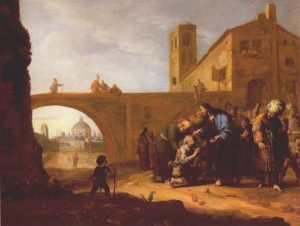
Title: Christ Heals the Blind Man Artist: Bartholomeus Breenbergh Medium: Oil on Canvas Date: 1635 Location: Liechtenstein State Art Collection, Vaduz.
Some people brought a blind man to (Jesus) and begged him to touch him. He took the blind man by the hand and led him out of the village; and when he had put saliva on his eyes and laid his hands on him, he asked him, ‘Can you see anything?’ And the man looked up and said, ‘I can see people, but they look like trees, walking.’Then Jesus laid his hands on his eyes again; and he looked intently and his sight was restored, and he saw everything clearly. Then he sent him away to his home, saying, ‘Do not even go into the village’ (Mark 8:22-26).
What is the motivation of the people at the beginning of this passage who drag a blind man to Jesus? They beg Jesus to touch this man. Do these people, whom Jesus leaves behind as soon as the introduction is made, genuinely care about the blind man? Or are they more interested in watching Jesus perform a magic show?
Jesus not only touches the man in question, he grabs him by the hand and walks him out of the village of Bethsaida, away from the people. No magic show today. This would be a private encounter between the blind man and the one who had recently provided sustenance for thousands in need.
Jesus proceeds to either lick his hands or spit on them, and then touches the man’s eyes. No incantation, only incarnation and a question similar to what we today might get when renewing a driver’s license or being tested for a new eyeglasses’ prescription: “Can you see anything?”
The first thing Mark tells us here is that the man “looked up.” Are we to infer that he had been “looking down” for a long time? When we look down, our line of sight diminishes; we close in on ourselves; we fail to catch view of things that can be seen.
Circumstances in life can cause us to look down. We have hard days that make us not want to see what might come next. And if I make a conscious effort not to see the bad, maybe I won’t get hurt. But when I put down my head to protect myself from the bad, I close off my life from the good, too.
I wonder what caused this man to turn away from the horizon and the heavens. Another gospel lesson refers to a man as being blind from birth (John 9). But I’m not sure that’s the case with the man in Mark’s story. When Jesus asks if he can see anything, the man responds: “I can see people, but they look like trees, walking.”
If the man had been blind his entire life, how did he know what people and trees looked like? My guess is this man once had vision, and maybe life had beaten him down to the point that he simply didn’t want to see anymore. At least, he didn’t want to see anything until Jesus walked him away from the people who associated this man with blindness.
The man’s sight begins to come back. But more work is needed. Jesus again touches the man’s eyes, and the man looks intently until his eyesight is restored and he sees everything clearly. There is effort on Jesus’s part. And for the man’s vision to fully return, effort is needed on his part, as well. Jesus then orders him not to return to the community in which he was blind.
Lent can be a time when Jesus takes us by the hand, walks us away from the events of life that steal our spiritual vision, so that he can help us see again. But maybe there’s only so much Jesus can do. Could it be that for us to see clearly, Jesus needs us to look intently?
“I invite you, therefore, in the name of the Church, to the observance of a holy Lent” (The Book of Common Prayer, page 265).
